The global algae-based anti-aging products market is projected to grow from USD 2,001.3 million in 2025 to approximately USD 6,160.5 million by 2035, recording an absolute increase of USD 4,150.8 million over the forecast period. This translates into a total growth of 207.4%, with the market forecast to expand at a compound annual growth rate (CAGR) of 11.9% between 2025 and 2035. The overall market size is expected to grow by nearly 3.1X during the same period, supported by the rising consumer awareness of marine-derived skincare benefits and increasing demand for sustainable, natural anti-aging solutions.
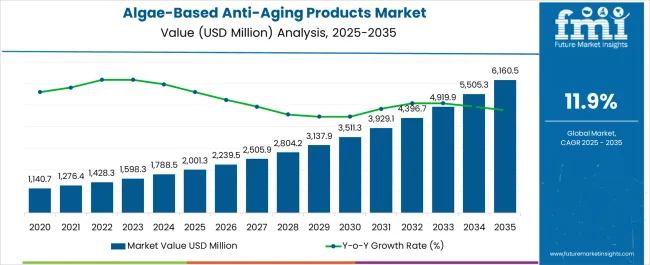
Between 2025 and 2030, the Algae-Based Anti-Aging Products market is projected to expand from USD 2,001.3 million to USD 3,508.9 million, resulting in a value increase of USD 1,507.6 million, which represents 36.3% of the total forecast growth for the decade. This phase of growth will be shaped by rising penetration of marine biotechnology in skincare formulations, increasing consumer preference for sustainable beauty solutions, and growing awareness about the anti-aging benefits of algae-derived compounds. Beauty manufacturers are expanding their marine ingredient portfolios to address the growing complexity of natural anti-aging formulation requirements.
From 2030 to 2035, the market is forecast to grow from USD 3,508.9 million to USD 6,160.5 million, adding another USD 2,643.2 million, which constitutes 63.7% of the overall ten-year expansion. This period is expected to be characterized by advancement of marine biotechnology extraction methods, integration of sustainable sourcing technologies, and development of sophisticated algae cultivation platforms across different production channels. The growing adoption of circular economy principles and bio-based formulation approaches will drive demand for more advanced algae-derived anti-aging ingredients.
Between 2020 and 2025, the Algae-Based Anti-Aging Products market experienced significant expansion, driven by technological breakthroughs in marine biotechnology and increasing consumer awareness of sustainable beauty ingredients. The market developed as consumers became increasingly conscious of environmental impact while seeking effective anti-aging solutions, and beauty brands recognized the potential of algae-derived actives to deliver both efficacy and sustainability credentials.
| Metric | Value |
|---|---|
| Estimated Size (2025E) | USD 2,001.3 million |
| Projected Value (2035F) | USD 6,160.5 million |
| CAGR (2025 to 2035) | 11.9% |
Market expansion is being supported by the rapid advancement of marine biotechnology and increasing consumer demand for sustainable, natural anti-aging solutions that address environmental concerns while delivering proven skincare benefits. Modern consumers seek products that combine efficacy with environmental responsibility, moving away from synthetic ingredients toward scientifically-validated, ocean-derived formulations that deliver measurable anti-aging results.
The growing sophistication of algae extraction and processing technologies, including advanced fermentation methods, supercritical extraction, and biotechnological cultivation systems, is enabling more potent and stable algae-derived actives while driving demand for marine-based formulation platforms. Beauty brands are increasingly investing in sustainable sourcing and marine biotechnology capabilities to offer differentiated products that can provide superior anti-aging benefits while maintaining environmental responsibility.
The market is segmented by source, function, product type, channel, and claim. By source, the market is divided into brown algae extracts, red algae extracts, green algae extracts, and microalgae-derived actives. Based on function, the market is categorized into anti-aging & wrinkle reduction, skin firming & elasticity, hydration support, and UV/blue light protection. In terms of product type, the market is segmented into serums, creams/lotions, masks, and ampoules. By channel, the market is classified into e-commerce, pharmacies, specialty beauty retail, and mass retail. By claim, the market includes natural/organic, vegan, clean-label, COSMOS-certified, and others. Regionally, the market is divided into North America, Europe, East Asia, South Asia & Pacific, Latin America, and Middle East & Africa.
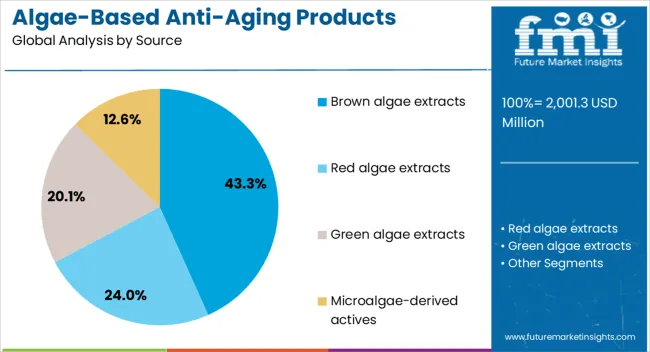
Brown algae extracts are projected to account for 43.3% of the Algae-Based Anti-Aging Products market in 2025, establishing their position as the leading source category in the global marketplace. This dominant market share is fundamentally supported by the rich concentration of bioactive compounds found in brown algae, including fucoidans, alginates, and phenolic compounds that demonstrate proven anti-aging properties and skin protection benefits.
The preference for brown algae extracts stems from their ability to provide comprehensive anti-aging benefits through multiple mechanisms, including antioxidant protection, collagen synthesis stimulation, and skin barrier enhancement. Brown algae species such as Laminaria, Fucus, and Ascophyllum contain unique polysaccharides and peptides that have been scientifically validated for their ability to improve skin elasticity, reduce fine lines, and provide long-lasting hydration.
The market leadership of brown algae extracts is further reinforced by their versatility in formulation applications and compatibility with various product types, from lightweight serums to intensive anti-aging creams. The segment benefits from well-established supply chains, sustainable harvesting practices, and extensive research supporting their efficacy in anti-aging applications.
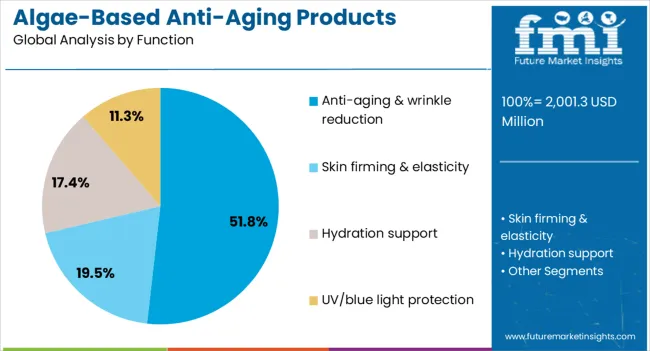
Anti-aging & wrinkle reduction products are expected to represent 51.8% of algae-based anti-aging products demand in 2025, establishing their dominance in the global market landscape. This commanding market position reflects the primary consumer concern about visible signs of aging and the desire for targeted solutions that can address wrinkle formation, skin texture irregularities, and age-related skin deterioration.
The anti-aging & wrinkle reduction segment benefits from the sophisticated bioactive compounds found in various algae species that can stimulate collagen production, improve skin elasticity, and reduce the appearance of fine lines and wrinkles. Modern algae-based anti-aging formulations feature concentrated marine peptides, antioxidant complexes, and moisture-binding polysaccharides that work synergistically to restore youthful skin appearance.
The segment's growth is further supported by the aging global population, increasing awareness of marine-derived skincare benefits, and the proven effectiveness of algae extracts in clinical studies demonstrating visible improvements in skin firmness, texture, and overall appearance. Algae-based anti-aging products offer consumers natural alternatives to synthetic anti-aging ingredients while delivering measurable results.
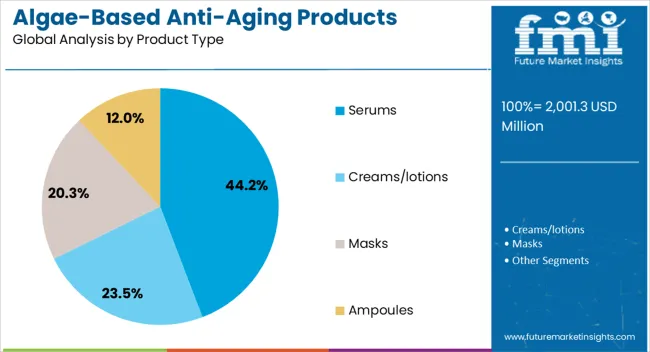
Serums are projected to contribute 44.2% of the algae-based anti-aging products market in 2025, representing the preferred product format for delivering concentrated marine actives. This delivery format aligns perfectly with consumer preferences for lightweight, fast-absorbing formulations that can deliver high concentrations of bioactive algae compounds directly to the skin.
The competitive advantage of serum formulations lies in their ability to incorporate higher concentrations of algae extracts and marine actives compared to other product types, enabling more targeted and intensive anti-aging treatments. Serums provide optimal delivery of water-soluble algae compounds such as polysaccharides and peptides while maintaining product stability and efficacy.
Serums offer consumers precision application, faster absorption, and the ability to layer with other skincare products, making them ideal for incorporating algae-based anti-aging benefits into existing skincare routines. The format supports higher active concentrations while enabling brands to showcase the potency and efficacy of their marine-derived ingredients.
The Algae-Based Anti-Aging Products market is advancing rapidly due to technological innovation in marine biotechnology and increasing consumer demand for sustainable beauty solutions. However, the market faces challenges including high extraction and processing costs for marine ingredients, seasonal availability of certain algae species, and varying regulatory requirements for marine-derived cosmetic ingredients across different regions. Standardization of extraction methods and sustainable sourcing practices continue to influence market development patterns.
The growing deployment of sophisticated marine biotechnology including advanced fermentation systems, enzymatic extraction methods, and biotechnological cultivation platforms is enabling more efficient and sustainable production of algae-derived actives. These technologies provide higher yields of bioactive compounds while maintaining environmental sustainability and enabling year-round production independent of natural harvesting cycles.
Modern algae-based product development is incorporating comprehensive sustainability frameworks, including controlled cultivation systems, waste reduction protocols, and carbon-neutral production methods. Integration of circular economy principles, renewable energy utilization, and biodegradable packaging provides holistic environmental benefits that enhance brand positioning and consumer appeal.
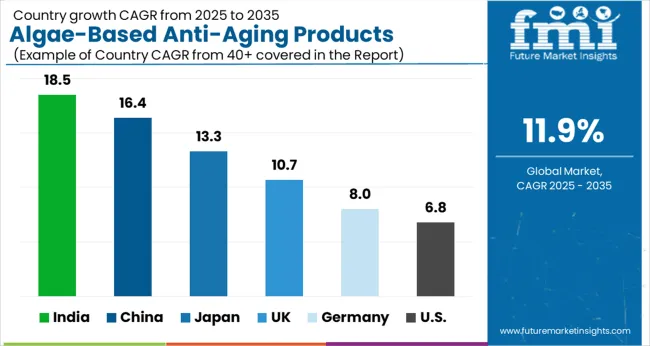
| Countries | CAGR (2025 to 2035) |
|---|---|
| India | 18.5% |
| China | 16.4% |
| Japan | 13.3% |
| UK | 10.7% |
| Germany | 8.0% |
| USA | 6.8% |
The algae-based anti-aging products market is growing rapidly across key regions, with India leading at an 18.5% CAGR through 2035, driven by rising disposable income, increasing awareness of marine-derived skincare benefits, and growing adoption of sustainable beauty solutions. China follows at 16.4%, supported by strong consumer interest in natural ingredients and expanding e-commerce infrastructure for specialty beauty products. Japan grows at 13.3%, emphasizing marine biotechnology innovation and premium natural skincare demand. The UK records 10.7% growth with focus on sustainable beauty trends and marine conservation awareness. Germany shows 8.0% growth driven by quality and environmental responsibility preferences. The USA demonstrates steady 6.8% growth with mature market adoption and established natural beauty channels.
Revenue from algae-based anti-aging products in India is projected to exhibit the highest growth rate with a CAGR of 18.5% through 2035, driven by rapid adoption of sustainable beauty solutions, increasing consumer awareness of marine-derived ingredients, and growing environmental consciousness among urban consumers. The country's expanding natural beauty market, combined with rising disposable income and preference for eco-friendly products, creates an ideal environment for algae-based anti-aging solutions.
Revenue from algae-based anti-aging products in China is expanding at a CAGR of 16.4%, supported by strong consumer interest in natural ingredients, advanced marine biotechnology development, and significant investment in sustainable beauty research. The country's sophisticated e-commerce ecosystem and growing environmental awareness create a favorable environment for innovative marine-derived skincare solutions.
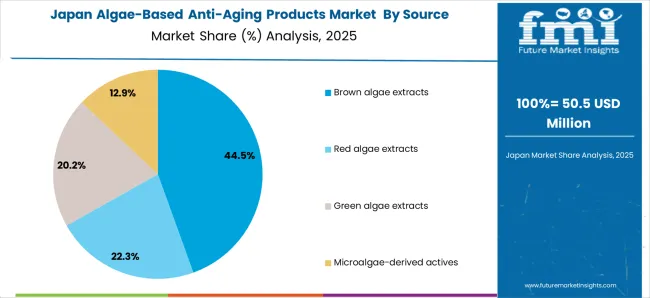
Revenue from algae-based anti-aging products in Japan is growing at a CAGR of 13.3%, driven by the country's leadership in marine biotechnology innovation, sophisticated consumer preferences for natural ingredients, and cultural appreciation for ocean-derived health and beauty benefits. Japanese consumers demonstrate high acceptance of scientifically-validated marine ingredients and willingness to invest in premium sustainable beauty products.
Demand for algae-based anti-aging products in the UK is projected to grow at a CAGR of 10.7%, supported by strong consumer interest in sustainable beauty solutions, established natural skincare market, and growing awareness of marine conservation issues. British consumers demonstrate high willingness to invest in environmentally-responsible beauty products that deliver proven anti-aging benefits through natural marine ingredients.
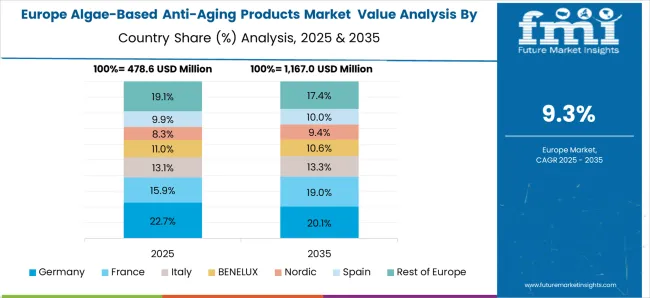
Demand for algae-based anti-aging products in Germany is expanding at a CAGR of 8.0%, driven by consumer preference for scientifically-validated natural skincare solutions, established environmental standards, and growing appreciation for marine biotechnology innovations. German consumers value sustainability, efficacy, and transparency in natural beauty products, creating strong demand for algae-based solutions that demonstrate clear environmental benefits and measurable anti-aging results.

Demand for algae-based anti-aging products in the USA is growing at a CAGR of 6.8%, characterized by diverse consumer segments, established natural beauty industry infrastructure, and steady adoption of sustainable skincare solutions. The American market demonstrates strong interest in marine-derived beauty innovations while maintaining focus on accessibility, proven results, and environmental credentials.
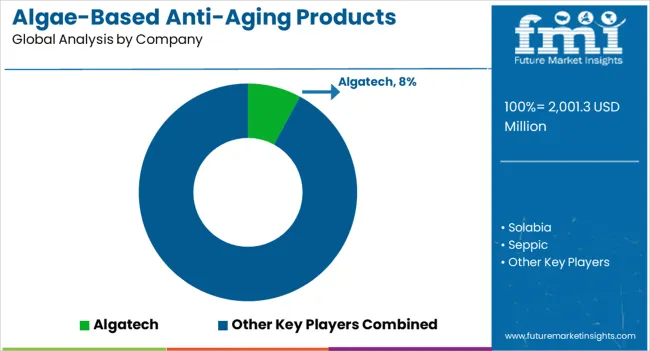
The algae-based anti-aging products market is characterized by competition among specialized marine biotechnology companies, established personal care manufacturers, and innovative natural beauty brands. Companies are investing in advanced algae cultivation systems, sustainable extraction technologies, marine biotechnology research, and direct-to-consumer platforms to deliver effective, environmentally-responsible, and innovative anti-aging solutions. Strategic partnerships, marine conservation initiatives, and sustainable sourcing practices are central to strengthening product portfolios and market presence.
Algatech leads the market with a 8% global value share in 2025, focusing on advanced marine biotechnology and sustainable algae cultivation systems. Solabia emphasizes premium marine actives and biotechnological innovation. Seppic provides comprehensive marine ingredient solutions with scientific validation. Ashland focuses on sustainable sourcing and marine biotechnology platforms.
| Items | Values |
|---|---|
| Quantitative Units (2025) | USD 2,001.3 Million |
| Source | Brown algae extracts, Red algae extracts, Green algae extracts, Microalgae-derived actives |
| Function | Anti-aging & wrinkle reduction, Skin firming & elasticity, Hydration support, UV/blue light protection |
| Product Type | Serums, Creams/lotions, Masks, Ampoules |
| Channel | E-commerce, Pharmacies, Specialty beauty retail, Mass retail |
| Claim | Natural/organic, Vegan, Clean-label, COSMOS-certified |
| Regions Covered | North America, Europe, East Asia, South Asia & Pacific, Latin America, Middle East & Africa |
| Countries Covered | United States, Canada, United Kingdom, Germany, France, China, Japan, South Korea, India, Brazil, Australia and 40+ countries |
| Key Companies Profiled | Algatech, Solabia, Seppic, Ashland, Givaudan, BASF, DSM-Firmenich, Codif, Greentech, and Croda |
The global algae-based anti-aging products market is estimated to be valued at USD 2,001.3 million in 2025.
The market size for the algae-based anti-aging products market is projected to reach USD 6,160.5 million by 2035.
The algae-based anti-aging products market is expected to grow at a 11.9% CAGR between 2025 and 2035.
The key product types in algae-based anti-aging products market are brown algae extracts, red algae extracts, green algae extracts and microalgae-derived actives.
In terms of function, anti-aging & wrinkle reduction segment to command 51.8% share in the algae-based anti-aging products market in 2025.






Full Research Suite comprises of:
Market outlook & trends analysis
Interviews & case studies
Strategic recommendations
Vendor profiles & capabilities analysis
5-year forecasts
8 regions and 60+ country-level data splits
Market segment data splits
12 months of continuous data updates
DELIVERED AS:
PDF EXCEL ONLINE
Products from Food Waste Industry Analysis in Korea Size, Share and Forecast Outlook 2025 to 2035
Products from Food Waste in Japan - Size, Share, and Forecast Outlook 2025 to 2035
Products from Food Waste Market Analysis - Size, Growth, and Forecast 2025 to 2035
USA Products from Food Waste Market Growth – Trends, Demand & Outlook 2025-2035
Teff Products Market
Detox Products Market Analysis - Size, Share, and Forecast Outlook 2025 to 2035
Algae Products Market Analysis - Size, Share, and Forecast Outlook 2025 to 2035
Pulse Products Market Analysis - Size, Share, and Forecast Outlook 2025 to 2035
Dairy Products Market Analysis by Product Type, End Use, Distribution Channel and Region through 2035
Almond Products Market Size and Share Forecast Outlook 2025 to 2035
Bamboo Products Market Analysis – Trends & Growth 2025 to 2035
Luxury Products For Kids Market - Trends, Growth & Forecast 2025 to 2035
Chicory Products Market Size and Share Forecast Outlook 2025 to 2035
Crystal Products Market Size and Share Forecast Outlook 2025 to 2035
Make-Up Products Packaging Market Size and Share Forecast Outlook 2025 to 2035
Suncare Products Market Size and Share Forecast Outlook 2025 to 2035
Ziplock Products Market Size and Share Forecast Outlook 2025 to 2035
Global Moringa Products Market Outlook – Trends, Demand & Forecast 2025–2035
Corn Co-Products Market
Skincare Products Market Size and Share Forecast Outlook 2025 to 2035

Thank you!
You will receive an email from our Business Development Manager. Please be sure to check your SPAM/JUNK folder too.
Chat With
MaRIA